Premier League reranked: Man United find footing, Spurs on unsustainable path
Among soccer nerds, it’s generally accepted that we can start making confident statements about team performance once we hit the 10-game mark of the Premier League season.
It’s a random, low-scoring sport where conversion rates fluctuate massively from game to game, and the same is true for individual and team-level performances. Throw in unbalanced, lopsided schedules from team to team that don’t even out until we get to the end of the season, and there are so many ways you can get out over your skis by drawing too many conclusions before we get to Halloween.
But we’re only a couple of weeks away from putting our costumes on, so we’ve definitely learned some new things about the Premier League already. The question is: How do we figure out what’s real and what’s not?
To try to sift through the noise, Bill Connelly and Ryan O’Hanlon are back with the first edition of their Premier League power rankings since the season began. As always, they’ve each ranked the entire league from 1 to 20, combined their rankings, averaged them together, and come up with the final list.
How much have things changed over the first two months? Read on to find out.
The updated Premier League team rankings
We last did this in August, right before the season began. Our re-rankings — the combination of the individual rankings from Bill and Ryan — are listed along with the preseason rankings and each team’s present points total and goal differential in the Premier League table.
– Ranked: All 88 national teams that can win 2026 World Cup
– Is Mount the missing piece for Amorim at Man United?
– Wildest kits of the 2025-26 season
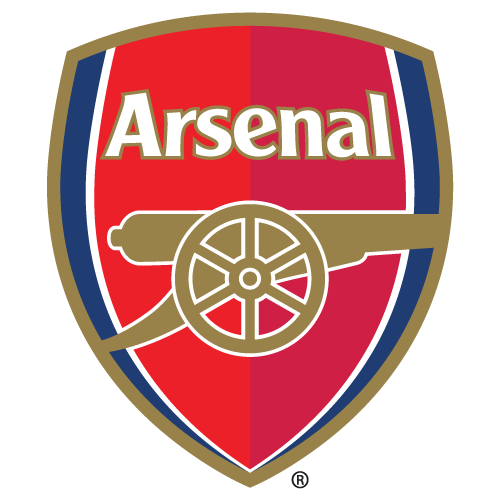 Arsenal: Back on top — for now?
Arsenal: Back on top — for now?
Here are some things that are true about Arsenal:
• They’ve already played three of the toughest fixtures on their schedule: away to Liverpool, home against Manchester City, and away to Newcastle.
• William Saliba has played only 65% of the available minutes.
• Bukayo Saka has played only 55% of the available minutes.
• Martin Ødegaard has played only 32% of the available minutes.
• Kai Havertz has played only 4.9% of the available minutes.
• Viktor Gyökeres has scored only two non-penalty goals.
Despite those things all being true, so too are these things:
• They’ve scored the second-most goals in the Premier League: 14
• They’ve given up the fewest goals in the Premier League: 3
• They have the best goal differential in the Premier League: plus-9
• They have the best expected goal differential in the Premier League: plus-7.5
• They have the most points in the Premier League: 16
1:20
Can Arsenal cope without Martin Ødegaard?
Gab Marcotti and Don Hutchison debate if Arsenal can cope without captain Martin Ødegaard after his recent injury setback.
Arsenal have easily been the best team through the first seven matches, and unless you think that all of Arsenal’s best players aren’t actually that good, and that Gyökeres is going to start scoring less often than he currently is, then Mikel Arteta’s team should get even better.
They’re not certainties to win the Premier League — there’s a long way to go — but we’re getting close to the point where the Gunners deserve to have greater title odds than the rest of the league put together. — O’Hanlon
 Liverpool: Work in progress
Liverpool: Work in progress
What will stability look like for big-spending Liverpool if or when it arrives? Because the first two months of this season have just been a straight adrenaline rush.
The champions lost two leads and lost to Crystal Palace on penalties in the Community Shield. They lost three more leads but still beat Bournemouth and Newcastle. They eked out late wins over Arsenal and Burnley, then lost another two-goal lead in an eventual Champions League win over Atlético Madrid. Then there were two more one-goal wins, followed by late collapses and three straight one-goal losses. Ten of their 11 matches have been decided by one goal, and the other was tied late.
This is just exhausting, and it has relegated the Reds from projected favorites in the Premier League and Champions League to secondary status in both. Ranking them third here almost felt generous.
1:32
Are concerns emerging over Arne Slot?
Steve Nicol and Craig Burley discuss Liverpool’s start to the season, as they believe Arne Slot has questions to answer.
There are worse places to be, of course. But until they get their transition defense right, it’s hard to see them reaching their goals. So far in Premier League play, they rank 11th in expected goals, or xG, allowed per shot and have gotten two or more defenders between shot and goal only 68.6% of the time (20th).
The top-line stats remain pretty solid: They’re first in possession rate (61.3%), first in combined progressive carries and passes, third in goals, et cetera. But as was expected when they signed a load of new attackers and two attack-friendly fullbacks, the balance is off. And it’s hard to fix that over the first half of the season, with nonstop fixtures and a trio of international breaks.
How long might it take Arne Slot to both get the new attack fully functional — Florian Wirtz and Alexander Isak, combined: one goal and one assist in 640 minutes — while heading off the issues at the back? — Connelly
 Wait, Spurs are ninth?
Wait, Spurs are ninth?
Tottenham are currently on pace to finish the season with 71 goals scored, 27 goals allowed and 76 points. Last season, those marks would’ve ranked third, first, and second. That prorated plus-44 goal differential would be just one behind Liverpool’s league-best and league-winning mark from last season.
And yet: we have Spurs ninth — exactly where we had them before the season started. Given that we both ranked Arsenal No. 1, are our North London allegiances showing? Aren’t they playing at a Champions League level? And after all, didn’t these guys, you know, finish last season in 17th?
They did — and their underlying numbers this season are even worse.
Under Ange Postecoglu last season, Spurs created 1.6 expected goals per game and conceded 1.7. This season, the defense has improved significantly (1.3 xG conceded per game), but the attack has cratered to 1.1 xG per game. And so, last season’s per-game xG differential was minus-0.1; this season’s is minus-0.2.
The explanation for Tottenham’s massively improved results, then, is mostly unsustainable finishing — at both ends of the field. They’re outperforming their xG by a greater degree than any other team in the league on the attacking end and on the defensive side.
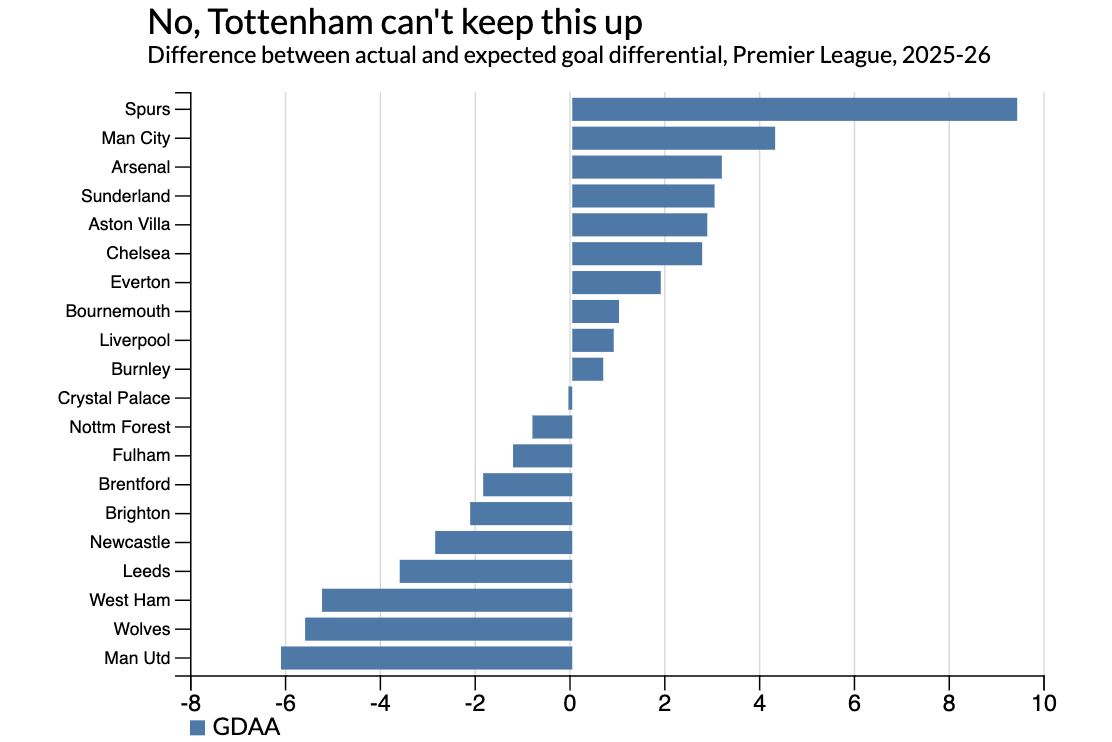
Unless Thomas Frank has created some new tactic that completely fools the models that drove the decision-making at his previous club, Brentford, then Spurs are going to come crashing back to earth at some point.
Per Opta’s power ratings, they’ve also played the second-easiest set of opponents in the league so far. The next few months could be rough. — O’Hanlon
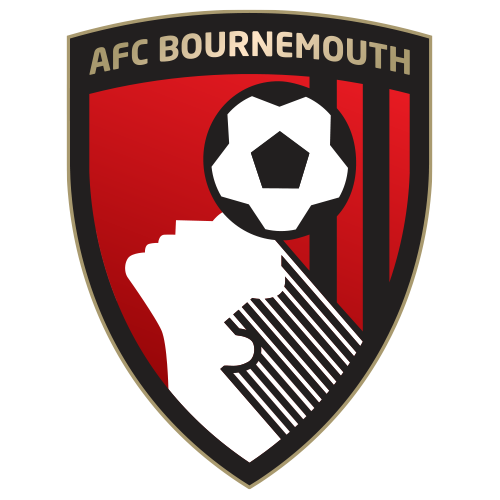
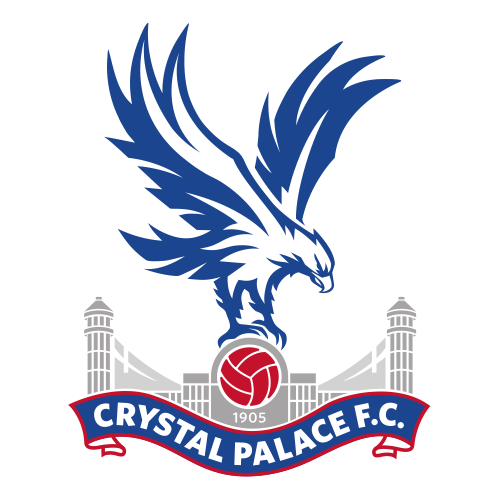 Whose rise is more sustainable: Bournemouth or Palace?
Whose rise is more sustainable: Bournemouth or Palace?
Bournemouth just keep inching closer and closer to the big time. They enjoyed their second top-10 finish in the first division in 2024-25, and they were close to something greater — they were within shouting distance of a Champions League place before injuries and poor depth caused a late crash.
About 20% of the way through this new season, they’re only two points out of first, having beaten Spurs and lost only to Liverpool. Palace, meanwhile, have won two trophies in the past five months, have beaten Liverpool twice and didn’t suffer their first league loss until Oct. 5.
Neither of these teams are particularly lucky to have landed spots in the top six at the moment — they’re both in the top eight in xG differential, and neither are overachieving dramatically against those xG figures. We ranked Bournemouth slightly ahead in the rankings above, and they did add quite a few new players (while also losing quite a few) in the search for better depth.
But can they last another 31 games at this level with such an exhausting style of play? They’re first in the league in ball recoveries (46.4 per game) and total defensive interventions (117.0 per game), and they play the most possessions per game (88.7) while allowing the fewest passes per defensive action (9.7), or PPDA, a good approximation of defensive intensity.
Palace aren’t nearly as intense, for better or worse. They rank 18th in PPDA (14.6), and they start just 4.5% of possessions in the attacking third (20th). But no one does a better job of creating great opportunities with very little of the ball.
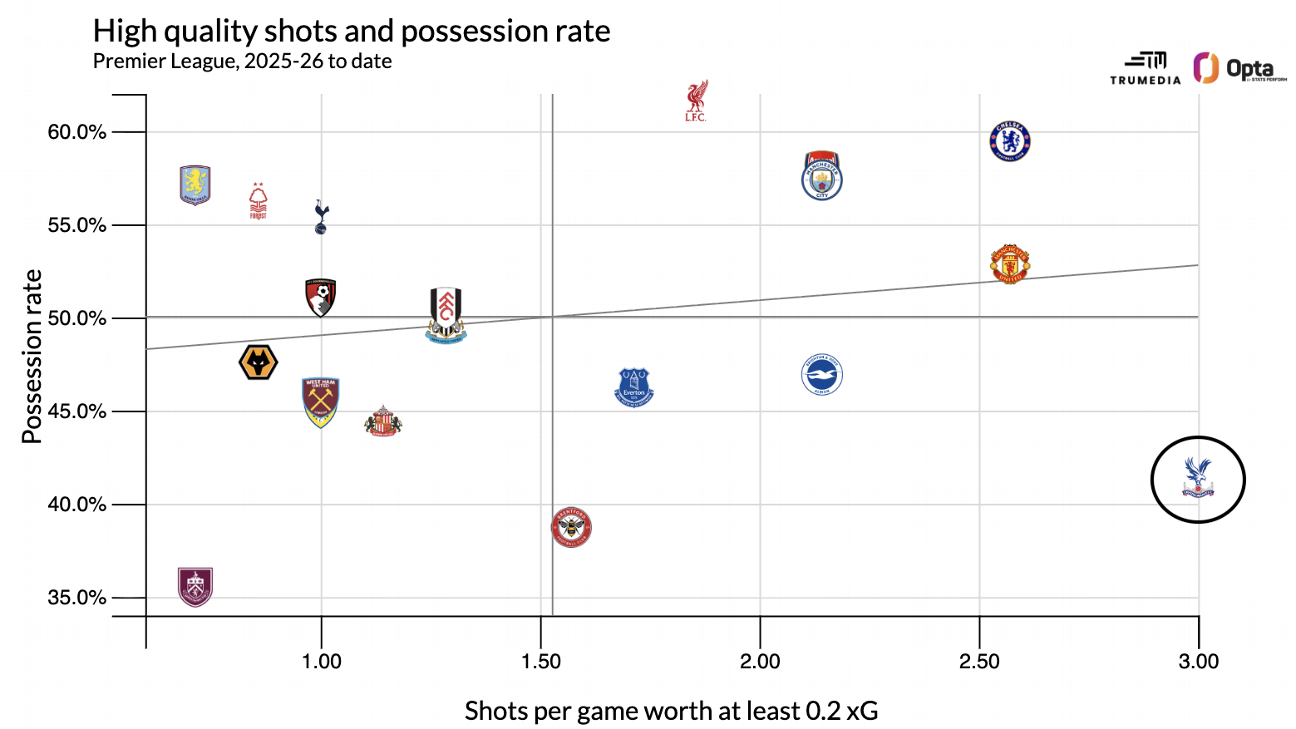
Oliver Glasner’s squad is thriving with an almost old-school defend-and-counter game. It’s less creative and exciting than Bournemouth’s style, but on the 10th anniversary of the ultimate defend-and-counter success story — Leicester City’s stunning title run — and in an age of energy conservation through long, arduous seasons, might this be the winning approach? — Connelly
 Manchester United might be finding some footing?
Manchester United might be finding some footing?
Over a long enough period of time, the expected and actual goal totals for a team are likely to line up pretty well. Over the short term, a lot of nonsense can happen. After seven matches, 14 Premier League teams have produced a scoring total within two goals of expectation, and four others are within four goals. But there are two incredible outliers early this season. We discussed Tottenham above; they’ve scored 5.5 more goals than their xG totals suggest they should have. And on the flipside, we have Manchester United, who are creating a league-leading 2.0 xG per game but are tied for eighth in actual goals.
Never let it be said that United have lost their flair for irony. They caught a lot of skepticism this offseason from the analytics community for signing both Bryan Mbeumo and Matheus Cunha after seasons in which their finishing was unsustainably good (and their prices were as high as they would ever be). The duo combined to attempt shots worth 20.9 xG last season — solid production, to be sure — but they scored 36 actual goals, a 72% overachievement that they were never going to sustain.
This season, in 948 league minutes, they’ve attempted shots worth 3.3 xG, a pace reasonably close to last season’s. But they’ve scored only once between them, underachievement of an almost perfectly symmetrical 70%. (Bruno Fernandes has pitched in as well, scoring only twice from shots worth 3.7 xG.)
1:34
Does Joshua Zirkzee have a future at Man United?
Gab Marcotti and Don Hutchison debate if Manchester United forward Joshua Zirkzee has a future at the club after reported loan interest from Roma.
That’s the bad (and funny) news. The good news is, this probably won’t last very long either. And when the xG gods stop having their fun, the fact that United rank first in shot attempts (15.7 per game), second in shots on goal (4.9), second in total shots worth at least 0.2 xG (2.6 per game), third in xG differential (+0.6), fifth in set-piece scoring margin (+1) and even third in shots allowed (9.1 per game) will probably start to matter more than whether or not Ruben Amorim refuses to vary his preferred 3-4-2-1 formation.
United aren’t attempting ridiculously high-quality shots — they’re only seventh in xG per shot (and 20th in xG allowed per shot) — but winning the shot-quantity battle by as much as they do tends to pay off over the long haul. — Connelly

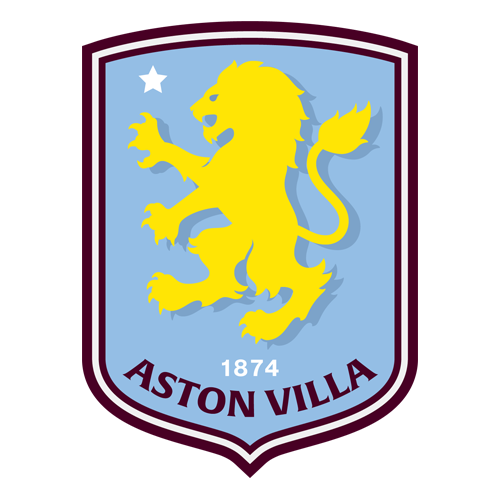 Brighton and Villa are stuck in mud
Brighton and Villa are stuck in mud
Before the season, Aston Villa and Brighton seemed like the two most likely outsiders to crash the top-five party. They both hung on to most of their key players; the former still has lots of talent and didn’t need to worry about Champions League matches this year; the latter had all kinds of young talent waiting to break out.
Well, with Brighton, we’re still waiting for those breakouts. Despite all of the young talent on the squad, only four goals have been scored by players who were 24 or younger at the time of the match. Six other teams have more. And while it’s a fun story that 34-year-old striker Danny Welbeck is still contributing more than a decade after winning a Premier League title under Sir Alex Ferguson, “Is Danny Welbeck still leading the team in goals?” is a good heuristic for the health of the Brighton project. And so far the answer is “yes” — he has scored twice.
Though Brighton have been somewhere around a league-average team overall, Villa have been much worse than that. Through seven matches, only West Ham, Nottingham Forest and Burnley have worse expected-goal differentials.
In particular, the attack has been unwatchable. Despite averaging more possession than Manchester City this season (57.1%), Villa have created 6.03 expected goals — fewer than any team other than Burnley. Ollie Watkins has played every game, he has scored one goal, and he’s attempting fewer than two shots per game.
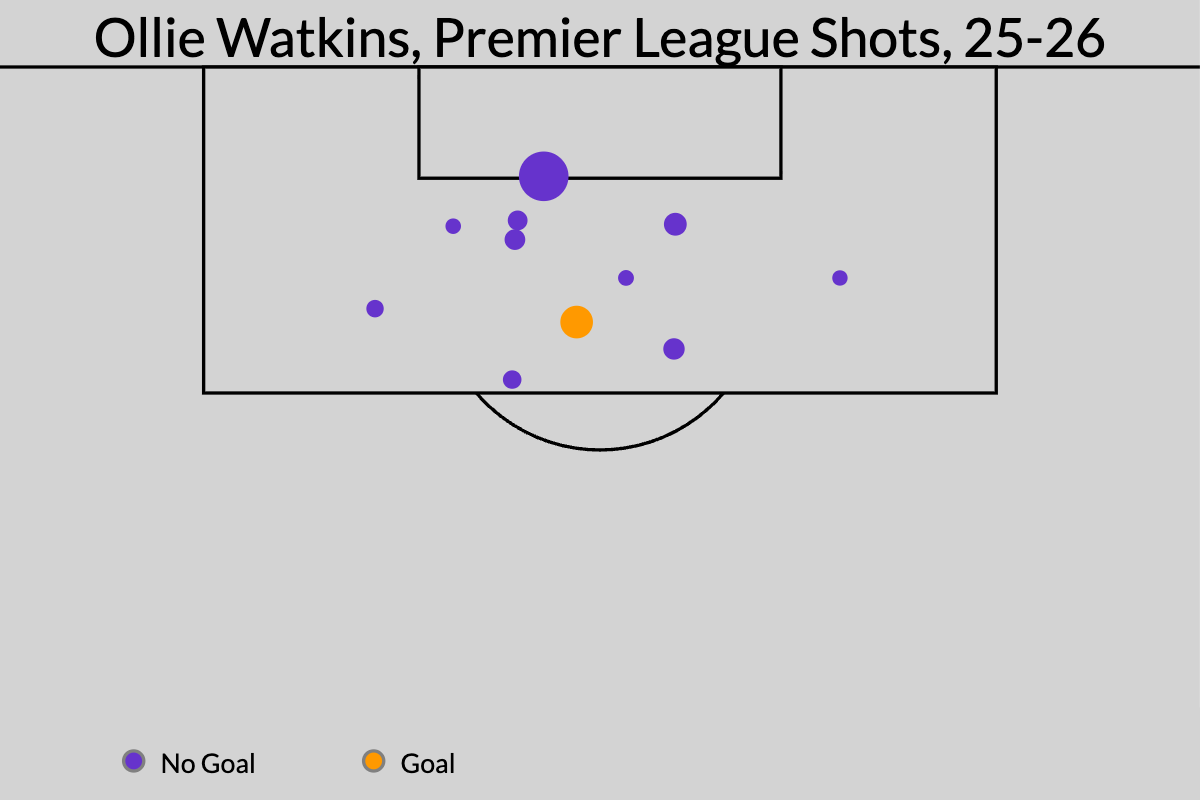
The scariest part of all of this: Villa still haven’t played Arsenal, Manchester City, Liverpool or Chelsea. — O’Hanlon

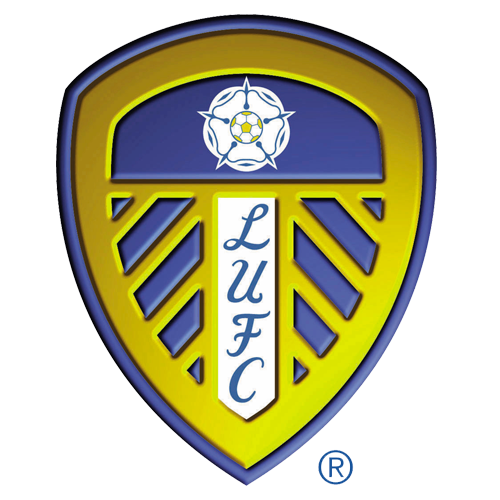
 Will two promoted teams survive?
Will two promoted teams survive?
This time last season, the three promoted teams (Leicester City, Ipswich and Southampton) had combined for 11 points in 21 combined games. Only one was technically in the relegation zone due to terrible starts from Crystal Palace and Wolves, but none were even slightly looking the part.
This season, the promotion trio of Sunderland, Leeds United and Burnley have combined for 23 points in 21 games. And though Burnley haven’t provided tons of hope regarding their survival — their xG differential of minus-1.2 goals per game is the worst in the league by a large margin — the other two seem to be in pretty sturdy shape.
We were reasonably optimistic about both Leeds and Sunderland heading into the season. They still looked like pretty likely relegation candidates — after two straight years of watching all three promoted teams go immediately back down, it was hard to think otherwise — but it appeared both teams had a decent amount to offer. Leeds looked as if they could create a decent combination of defensive organization and quick-strike attacking, and thus far they’ve done exactly that.
They rank 13th in goals allowed and a more encouraging sixth in xG allowed — meaning any future progression toward the mean could help them even more — and only 13.6% of their opponents’ touches in the attacking third have come in the box, the lowest in the league. That positively screams “defensive organization.”
Their attack is far from amazing, but they’re still averaging 1.0 goals per game (13th) from 1.1 xG (12th). Their three goals from set pieces rank fifth in the league as well, and “defend your butt off and score on set pieces” is the closest thing in the world to a tried-and-true recipe for surviving a relegation scrap.
Sunderland were the worst of the three promoted teams last season, but the moves they made in the offseason made loads of sense. “The club did as well as it could to add depth, plucking primarily from clubs known to develop young talent well,” we wrote in our August preview. “Throw in a boost of veteran leadership from [Granit] Xhaka and [Reinildo] Mandava, and this was a wonderfully logical offseason.”
Newcomers have provided 75% of Sunderland’s minutes, all of their assists (and 78% of their chances created), 81% of their ball recoveries, 81% of their progressive carries, 80% of their progressive passes and 53% of their shot attempts (though only 29% of their goals). This was a grand chemistry experiment, and it has paid off in the form of only two losses in their first seven matches.
They’re currently eighth in the table, and while their xG differential is sixth worst (not a great sign of where their form might go in the future), A) sixth-worst still isn’t relegation worthy, and B) they’ve stored up some points, and they’re seven points above the relegation zone.
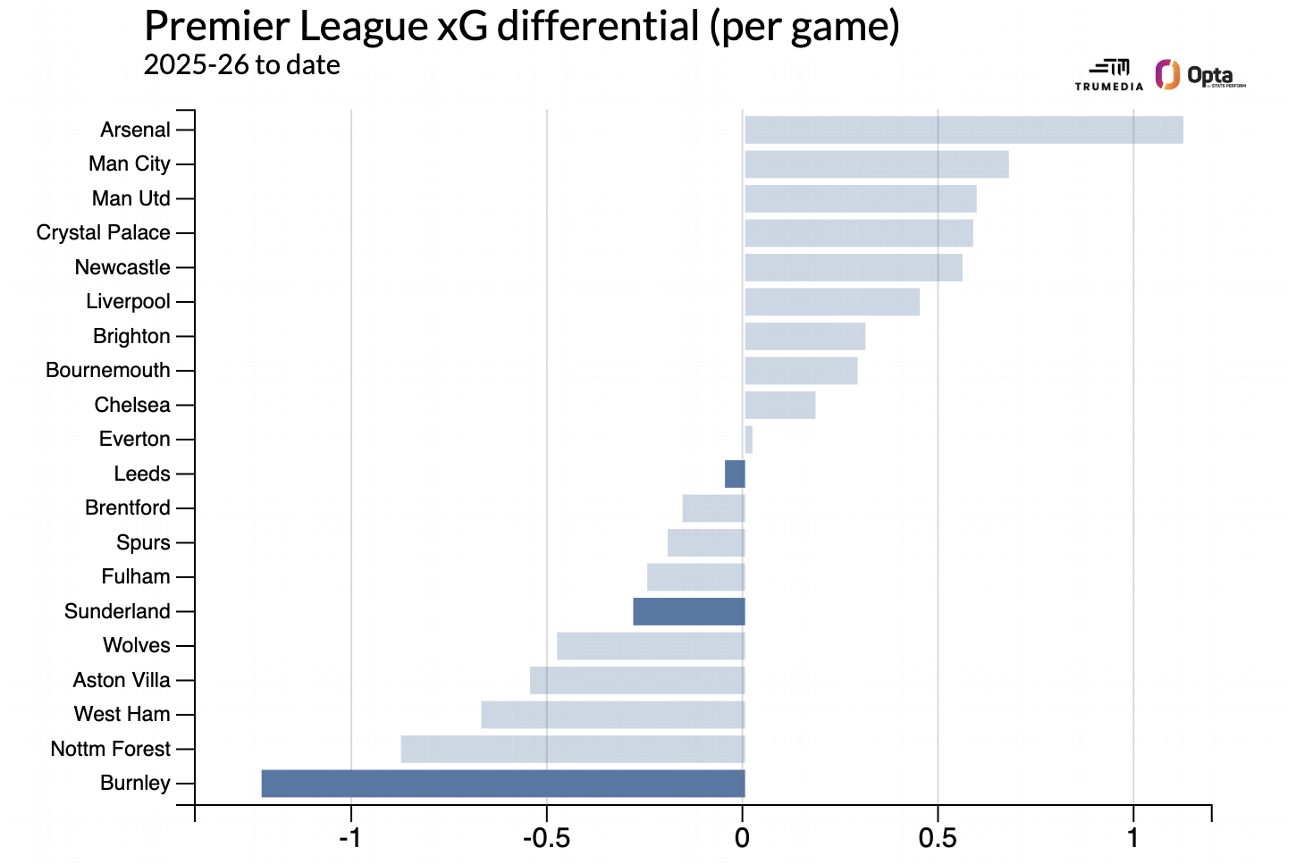
It’s a long season, but both Leeds and Sunderland are playing like Premier League-worthy teams. Better yet, some of the incumbents they’re trying to top are doing the exact opposite. — Connelly


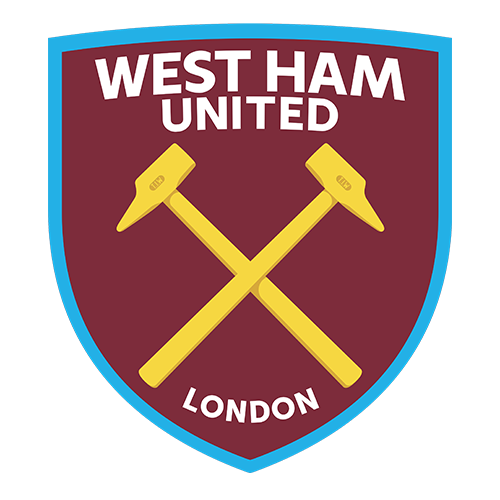 Who’s in the most danger: Forest, Wolves or West Ham?
Who’s in the most danger: Forest, Wolves or West Ham?
If you were hoping to avoid relegation, which of these teams would you rather be?
Team A: You have no wins and only two points — the fewest in the league. But you seem to trust your coach; at least, he knows his players and you didn’t hire him after the season started. And on top of that, your underlying performance hasn’t been that bad; you have the 16th-best xG differential in the league. Keep that up, and you’re bound to start winning points at a slightly higher clip.
Team B: You’re on your third permanent manager since January. You’ve conceded 16 goals — most in the league. And your six goals scored aren’t much better — second worst in the league. No one has been outscored by a bigger margin than you. Seven of your 10 most-used players will be 28 or older by the end of the season. You have four points, you’re in 19th, and your new manager was just fired by a team that’s only one point ahead of you in the table.
Team C: You finished in seventh last season. You are currently competing in the Europa League. You spent more money on transfer fees than Real Madrid and Paris Saint-Germain this past summer. Your new manager is the reigning Europa League champion. That new manager was also fired by his previous club despite winning the Europa League. This new manager has historically played a completely different style — wide-open, high-pressing, ultra-attacking — to the manager who guided your team to seventh place last season and whom you fired shortly after the current season began. You’re one point clear of the bottom three, but you have the second-worst xG differential in the Premier League.
If you haven’t figured it out yet: Team A is Wolves, Team B is West Ham, and Team C is Nottingham Forest. In these situations, when we’re choosing among undoubtedly bad teams, I’m always taking the points. So, give me Forest first, West Ham second, and Wolves third.
But if I were ranking the potential downsides of the three teams, I’d go in the opposite direction. Wolves will be bad but probably not spectacularly bad from here. West Ham might be the least athletic team in the league, and all of their key players are older. And Forest, with the added European stress, the obviously awful fit between players and manager, and the, uh, volatile owner, could just totally implode. — O’Hanlon


